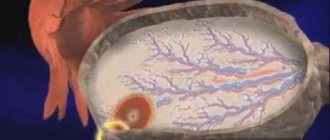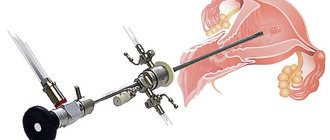Hexicon suppositories are an effective antibacterial agent that is widely used in the gynecological field. The drug is considered gentle and safe, due to which it is prescribed even to pregnant women.
Sometimes discharge appears after Hexicon. You need to figure out in advance whether they are considered normal or a cause for concern.
The use of Hexicon suppositories in gynecology
To understand why discharge appears, you must first understand what the drug is intended for and how it is used. The medication is used for therapeutic and prophylactic purposes. It is available in the form of suppositories and solution.
When treating with Hexicon, good results can be achieved. To do this, you just need to administer a suppository or douche twice a day. For prevention purposes, Hexicon suppositories are used a couple of hours after completion of unprotected sexual intercourse.
Doctors often prescribe Hexicon for thrush; we recommend reading in more detail about the specifics of using this drug in a separate article on our website.
Prevention
The drug is considered one of the most effective means used to prevent infectious diseases of the genitourinary system. Suppositories are used when barrier contraception was not used during coitus (intimacy) and there is a risk of penetration of pathogenic microorganisms.
In addition, suppositories are prescribed for preventive purposes in the following cases:
- before surgery or abortion;
- when examining the cavity of the reproductive organ;
- after installation of an ectopic device;
- before childbirth.
Treatment
The medication is used quite often for sexually transmitted diseases and in identifying pathologies such as:
They resort to using Hexicon during pregnancy. After making an accurate diagnosis, the doctor selects an adequate course of therapy and prescribes the appropriate dosage of the drug. The medication is considered gentle, which is why it is used even during gestation.
Contraindications and side effects
The only contraindications to the use of the drug are individual intolerance and allergies. In all other cases it can be safely used. It is quite well tolerated and is prescribed even to pregnant women.
Side effects of the drug are considered:
- itching in the genital area;
- dry mucous membranes;
- dermatitis.
The effect of Hexigon on vaginal secretion
Mucous discharge after the introduction of suppositories is observed in all women. Normally they are transparent, colorless and odorless. Their appearance is due to the dissolution of suppositories. The active component chlorhexidine is absorbed into the mucous membranes, and the excess comes out. Due to this, the medicine is gently removed from the body.
While taking the medication, there is no reaction of the vaginal microflora, but sometimes bloody discharge from Hexicon is possible. As a rule, women note that they do not leak much. This is a meager daub, the causes of which can be several.
Bloody discharge after taking the drug
The appearance of bleeding, according to doctors, is not associated with the use of suppositories. The medicine in this case is only a secondary factor. The cause of red leucorrhoea lies in something else, so we recommend reading in more detail about bloody discharge in women.
If, in addition to an uncharacteristic secretion, pain is observed in the lower abdomen, radiating to the lumbar region, there is a frequent urge to urinate and other unpleasant symptoms, then you should immediately go to a gynecologist for help.
Brown spotting due to the use of suppositories
The appearance of brown spotting is caused by the presence of caked blood in the reproductive organ or vagina. The drug does not provoke its appearance. Excess medication comes out along with the blood that has clotted earlier.
During pregnancy, such spotting after using a medication may be associated with freezing of the fetus in the womb. In this case, the woman needs urgent medical attention.
White, yellow and green discharge from candles
Green, white and yellow vaginal discharge is a warning sign. They indicate the presence of serious sexually transmitted pathologies that Hexicon is not able to cope with. In this case, it is necessary to conduct a thorough examination and select an effective therapeutic course using other medications.
Curd secret
A curdled discharge with a sour odor is a sign of candidiasis. This is a very common disease that Hexicon cannot cope with. Against the background of its use, the clinical manifestations of pathology often intensify. For this reason, women are prescribed other medications for thrush, and only after it is eliminated, this medication is used.
Reviews about the drug
Reviews from pregnant women do not generally contain negative connotations. A number of women noticed that Hexicon was used during pregnancy and after childbirth. Due to the weakening of the immune system, suppositories were prescribed as a preventive measure.
But some responses from pregnant women contain excited remarks. After using the drug, pinkish discharge appeared. Everyone’s body is different, and if alarming symptoms are visible, consultation with a gynecologist is mandatory.
Any amateur activity can harm the female body and the fetus!
- Hexicon vaginal suppositories are the safest for pregnant women among a number of analogues. This is a gentle method of treatment, the drug does not affect the placenta, lactobacilli remain in place, the effect is only positive if the body is healthy.
- Hexicon, according to reviews of nursing mothers, was prescribed to them as a preventive measure after childbirth. The medicine did not leave any unpleasant impressions on users, except for complaints of heavy discharge. After stopping use, my health improved.
- Considering the properties of the drug, it helps with vaginitis and cervicitis. Prevention of sexually transmitted diseases will help avoid the serious disease of ureaplasmosis. For any woman, this is a terrible disease, but for a pregnant woman it is simply an attack.
- Suppositories act on the body bypassing the digestive system, introduced as close as possible to the source of the disease, they envelop the vagina. Polyethylene oxide, which is part of the suppositories, removes pathogenic flora, causing abundant discharge, and leaves the mucous membrane clean. In isolated cases, it sometimes has a negative effect on pregnant women. But after childbirth it is recommended to use it.
Discharge and Hexicon suppositories during pregnancy
Watery discharge during pregnancy that appears after using a medication is considered normal. They are caused by the dissolution of candles and the release of excess to the outside. If bloody discharge appears from Hexicon suppositories, this is an alarming signal. It is necessary to immediately identify the reasons why such symptoms are observed.
Bloody discharge after Hexicon during pregnancy often indicates serious problems in the body. Such changes cannot be ignored.
Placental abruption
When using Hexicon, pink vaginal discharge during pregnancy sometimes appears due to placental complications. The woman needs to tell the doctor about this as soon as possible. As a rule, in addition to blood secretion, in the case of placental abruption, the following clinical manifestations are noted:
- pain localized in the area of detachment;
- protrusion of the wall of the reproductive organ;
- deterioration of the fetus' condition.
Are there any contraindications
Hexicon cannot harm the fruit. But if a woman’s body reacts to the composition of the drug as if it were an allergen, you should consult your doctor.
You should not wash your genitals with soap if you are using Hexicon suppositories during this period.
An alkaline environment will have a side effect. For disinfection, instead of soap, it is better to make a pink solution of potassium permanganate.
Rarely, but user reviews indicate this, itching, burning, irritation occurs, and the mucous membranes become dry. Monitor the condition of your body, be patient for 10 days, and if more serious problems arise, immediately consult a doctor.
Discharge after Hexicon suppositories: what is normal
The main active ingredient of suppositories is chlorhexidine. Polyethylene oxide gives the drug its solid form. It dissolves at body temperature, the resulting oily liquid moistens the vaginal mucosa. It is not absorbed, so part of it begins to leak out.
Suppositories can have a different color from white to yellowish, sometimes with a marbled tint. The discharge after dissolving the suppository is liquid, watery, and resembles the original color of the drug in color. But when mixed with vaginal contents, they can change the shade to a deeper yellow.
The color of the discharge also changes in the presence of a fungal infection, against which Hexicon is ineffective. Therefore, liquid discharge with white lumps appears from the genital tract, but the itching characteristic of thrush will persist. Chlorhexidine also will not help with viruses, and vaginal lactobacilli do not die under its influence.
To clearly distinguish between normal and pathological discharge after suppositories, you need to pay attention to the following:
- time of appearance;
- color;
- smell;
- additional sensations.
If fluid from the vagina appears 15-20 minutes after placing the suppository, then this is the result of melting of the drug. Discharges that become pronounced after a few hours are considered pathological.
The color should be close to the natural shade of the suppository. But when using Hexicon, pinkish or yellowish is allowed. The smell remains natural, there should be no stench.
Hexicon has an irritating effect, so many people complain of itching and burning, which bother them a few hours after placing the candle. This condition is not normal, so treatment should be stopped.
Contraindications and side effects of the drug
Hexicon is well tolerated in most cases. But if allergic reactions to its components are ever registered, this drug should be replaced with a similar product. Most often, an increased reaction manifests itself in the form of itching and burning of the genitals.
In the presence of dermatitis or other skin diseases in the acute period, treatment with hexicon should also be postponed or replaced with a less irritating and aggressive agent.
The drug should not be used simultaneously with other suppositories, especially those containing iodine, as the effect of treatment may be reduced.
Bloody discharge after Hexicon during pregnancy
If bloody discharge appears during pregnancy after Hexicon suppositories, you must stop treatment and consult a doctor. There may be several reasons for this condition:
Pregnant women often show signs of erosion due to hormonal changes. The pathological focus becomes inflamed due to a natural decrease in immunity, and an infection occurs. Suppositories irritate the surface of the exocervix, which leads to the appearance of a small amount of blood. In this case, the drug must be replaced with another.
Chlorhexidine is not capable of leading to a threat of miscarriage or causing placental abruption. But against the background of a genital tract infection, there is a risk of infection of the fetus. Therefore, bloody discharge appears early on, simultaneously with the start of chlorhexidine therapy. This condition is accompanied by additional symptoms. The woman feels a nagging, cramping pain in the abdomen, which can radiate to the sacrum.
Important! If a lot of scarlet blood appears, the child becomes very active, emergency hospitalization is necessary. These may be signs of placental abruption, a condition that threatens the life of the child and mother.
Less commonly, blood on underwear is the result of trauma to the vagina due to careless insertion of a suppository. Inflamed tissues become swollen, and additional blood flow occurs to them. Therefore, even a small wound with a nail will lead to the appearance of red drops. But they will become noticeable a few minutes after inserting the suppository.
Brown discharge after Hexicon during pregnancy
The cause of brown discharge must be determined depending on the period of its appearance. In the first trimester, they are an indicator of detachment of the ovum. But Hexicon is not the provocateur of this condition. It occurs due to embryo pathology. Most often, early miscarriages occur due to infectious causes. Chlorhexidine fights microorganisms, but sometimes they already manage to penetrate the uterus.
To sanitize the vagina before childbirth, Hexicon is prescribed during pregnancy in the 3rd trimester, and the discharge may initially be normal and then turn brown. If a woman has a full-term pregnancy of 38 weeks or more, then mucous with a brown tint is a mucus plug, which indicates the ripening of the cervix and preparation for childbirth.
What happens after use
The course of taking the medication is traditionally 7-10 days, during which it is recommended to administer 2 suppositories per day during pregnancy, in the morning and in the evening.
Transparent watery discharge in women is considered a normal and natural condition. If the situation has changed, the mucus has acquired a bloody appearance, patients rightfully begin to worry. In such cases, it is necessary to urgently consult your doctor, who will explain why such symptoms appeared and how to stop them.
Any medication can cause adverse reactions, and Hexicon is no exception in this sense. Vaginal suppositories change the microflora of the vagina. Although it is believed that chlorhexidine has no effect on lactobacilli, under the influence of various factors the situation can change, both in the normal state and during pregnancy.
Signs appear most often on the second or third day after starting to use the medicine and are associated with the following diseases and conditions:
Spontaneous termination of pregnancy
Bloody discharge after the introduction of suppositories indicates the threat of losing the child. Usually accompanied by pain in the lower abdomen, uterine tone, and the urge to go to the toilet. The use of the drug may be a primary or secondary cause. If the shape of the cervix is not changed, the pharynx is not open, this is only a threatening miscarriage, in which rest, relaxation of smooth muscles, and mainly non-drug methods of influence in a hospital setting are recommended.
The interruption that has begun is characterized by more pronounced symptoms. At the first examination, the doctor explains what dangers this condition poses for mother and child. A specialist can determine the different types of spontaneous abortion based on how long the discharge continues during pregnancy and identifying its nature.
Insufficient diagnosis
Pink, yellow or curdled mucus after using the product may be associated with a concomitant disease that could not be detected in time. With cervicitis and colpitis, the vessels become less elastic and are subject to microtrauma, which leads to such manifestations. The doctor is obliged to warn the patient about these signs that appear after the administration of suppositories, especially during pregnancy. Discharge usually begins on the second day of treatment. It is important to pay attention to the clinical picture, as it sometimes indicates fibroids and malignant tumors.
Erosion
Due to infectious pathologies, ulcers appear on the cervix. In turn, displacement of the columnar epithelium can lead to formations. In this case, exudate appears in the affected areas, described as pink or brown discharge. After a woman begins to put suppositories, the symptoms become more pronounced, which is associated with the specific reaction of the vaginal microflora to suppositories.
Methods of treatment for eliminating discharge
It should be noted that suppositories have the characteristic feature of melting at a certain temperature and environment. These properties are expressed in abundant manifestations of mucus, slightly yellowish in color, which is considered normal. That is why it is recommended to use candles at night or use a pad when using during the day.
If the discharge is accompanied by pain, itching, burning, or blood clots are detected, you should immediately stop taking it and consult a doctor. The specialist identifies possible pathologies and prescribes adequate treatment:
- In case of adverse reactions, the gynecologist prescribes Epigen in the form of a spray, if there are no contraindications to the glycyrrhizic acid contained in the drug. It induces the production of interferon, increases local immunity, disrupts the synthesis of pathogens in the early stages, and accelerates epithelization of the mucosa. It is recommended to spray the cavity 5-6 times a day for 5 days.
- In case of overdose, the drug is discontinued, the patient's condition is monitored for 72 hours, after which suppositories can be placed again if there are no complications and further treatment is required.
- For erosions during pregnancy, the gynecologist prefers to first make a diagnosis using colposcopy. If the results are negative, therapeutic measures are transferred to the postpartum period. If indications require an urgent slowdown of the process of damage to epithelial cells, laser coagulation or radio wave therapy is prescribed.
- In other cases, erosion is cauterized using diathermy.
- To get rid of thrush, Terzhinan suppositories are recommended for women, including expectant mothers. The neomycin contained in the drug transcribes the genetic code, which leads to the death of the strain.
- An alternative remedy is Livarol. Local use of the drug does not have a negative effect on the development of the fetus, since it is not absorbed into the blood. The course of treatment is 20 days, subject to administration once a day.
- Terzhinan also copes well with the restoration of microflora during dysbiosis. The therapeutic period in this case is reduced to 10 days.
- Myoma is a dangerous disease, especially if the formation tends to grow. When carrying a child, drastic measures are postponed until the postpartum period, if there is no danger. But the expectant mother is constantly under surveillance.
- For preventive and therapeutic purposes, in the presence of fibroids, a course of Curantil, Magne B6 and Actovegin is prescribed twice a day for 14-28 days.
Discharges of various types after using Hexicon may have various causes. If the etiology is natural and entails complications, therapy should not be stopped. Otherwise, the drug is replaced with an appropriate option. In any situation, you need to consult a leading doctor who will find out the cause of the discharge, conduct a diagnosis, and prescribe appropriate therapy, dosage and course.
How and in what doses to use
Mandatory administration of suppositories, in a lying position, at night. It is advisable not to get up for about two hours, lie on your back and raise your pelvis slightly higher than your body.
It won't hurt to use a pad; heavy discharge is expected. You can roll up a tampon, which will prevent the melted candle from quickly expiring.
Strong liquid discharge at this moment should not be alarming; this is normal. This is how Hexicon suppositories work. If you have to work during the day, then plan for this, use a pad, not a thin one, but the kind you use during menstruation.
For 7-20 days, a course of vaginal administration may be prescribed at night and early in the morning. You need to insert the candle early; you should be in bed for at least 2 hours. Application twice a day is sufficient if there has been no intimacy with an unfamiliar partner during the day. Plan the meeting so that two hours after the act, a vaginal suppository can be inserted.








